The AMD Radeon R9 290 Review
by Ryan Smith on November 5, 2013 12:01 AM EST- Posted in
- GPUs
- AMD
- Radeon
- Hawaii
- Radeon 200
Overclocking
Finally, let’s spend a bit of time looking at the overclocking prospects for the 290. Without any voltage adjustment capabilities and with AMD binning chips for clockspeeds and power consumption we’re not necessarily expecting a lot of headroom here, but none the less it’s worth checking out to see how much more we can squeeze out of the card.
Even though we’re officially limited to AMD’s Overdrive utility for the moment for overclocking, Overdrive offers a wide enough range of values that we shouldn’t have any problem maxing out the card. In fact we’ll be limited by the card first.
| Radeon R9 290 Overclocking | |||
| Reference Radeon R9 290 | |||
| Shipping Core Clock | 662MHz | ||
| Shipping Boost Clock | 947MHz | ||
| Shipping Memory Clock | 5GHz | ||
| Shipping Boost Voltage | ~1.18v | ||
| Overclock Core Clock | 790MHz | ||
| Overclock Boost Clock | 1075MHz | ||
| Overclock Memory Clock | 5.6GHz | ||
| Overclock Max Boost Voltage | ~1.18v | ||
Despite the lack of voltage control, when it comes to overclocking the 290 we were able to achieve solid overclocks on both the GPU and the memory. On a boost clock basis we were able to push the 290 from 947MHz to 1075MHz, an increase of 128MHz (14%). Meanwhile we were able to push the memory from 5GHz to 5.6GHz before artifacting set in, representing a 600MHz (12%) memory overclock. Being able to increase both clockspeeds to such a similar degree means that no matter what the video bottleneck is – be it GPU or memory – we should see some kind of performance increase out of overclocking.
On a side note, for overclocking the 290 we stuck with moderate increases to both the maximum fan speed and the PowerTune limit. In the case of the former we used a 65% maximum fan speed (which actually proved to be more than what’s necessary), while for the latter we went with a 20% increase in the PowerTune limit, as at this point in time we don’t have a good idea for what the safe power limits are for the reference 290/290X board. Though in either case only FurMark could push the overclocked card to its power limit, and nothing could push the card to its fan speed limit. Similarly we didn’t encounter any throttling issues with our overclocked settings, with every game (including CoH2) running at 1075MHz sustained.
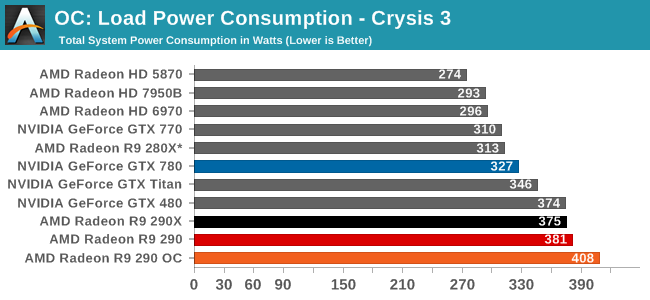
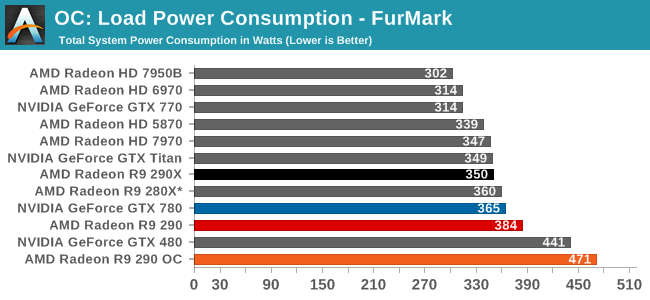
Taking a brief look at power, temp, and noise before jumping into our gaming performance results, we can see that overclocking the card has a measurable impact on power consumption under both Crysis 3 and FurMark. With Crysis 3 we’re clockspeed limited before we’re power limited, leading to an increase in power consumption of 27W, while under FurMark where we were power limited it’s a much more academic increase of 87W.
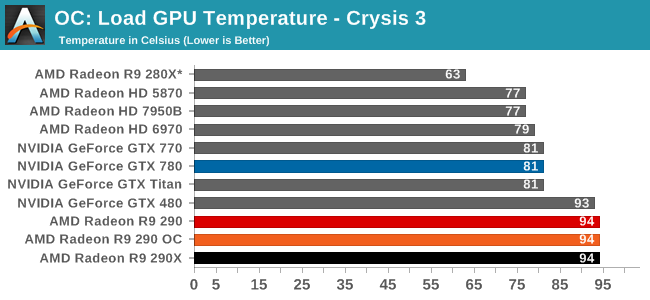
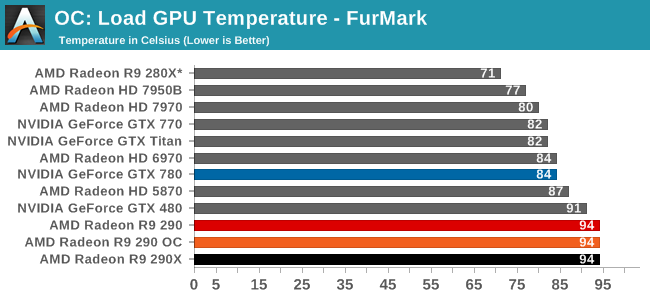
Since the 290 already ships at the highest temperate limit it allows – 95C – our sustained temperatures are unchanged even after overclocking.
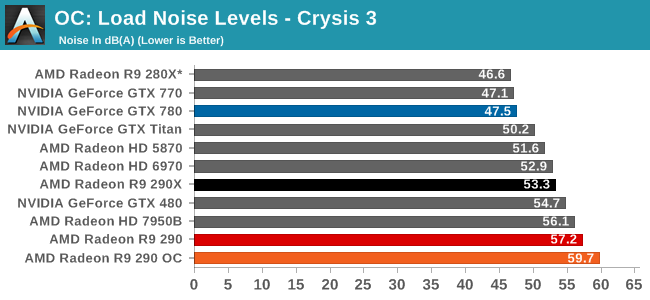
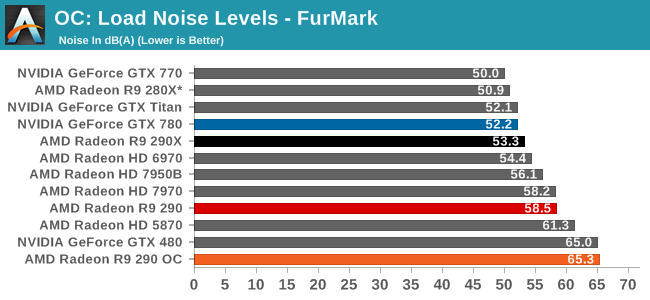
The 290 is already an unreasonably loud card at stock, and unfortunately the fan speed increases needed to handle the greater heat load from overclocking only make this worse. Under Crysis 3 we peaked at 59.7dB, or 49% fan speed. While under FurMark we peaked at 65.3dB, or 59% fan speed. For these noise levels to be bearable the 290 really needs to be fully isolated (e.g. in another room) or put under water, as otherwise 59.7dB sustained is immensely loud for a video card.
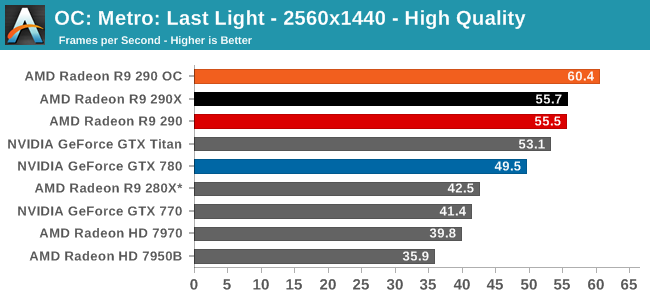
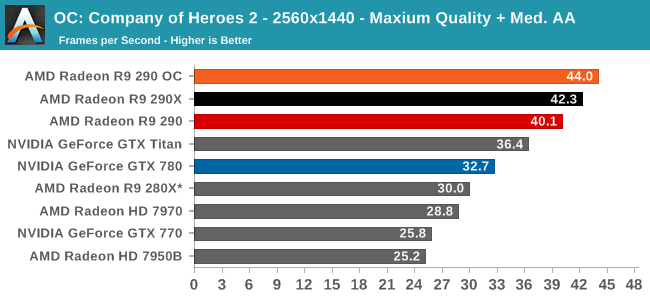
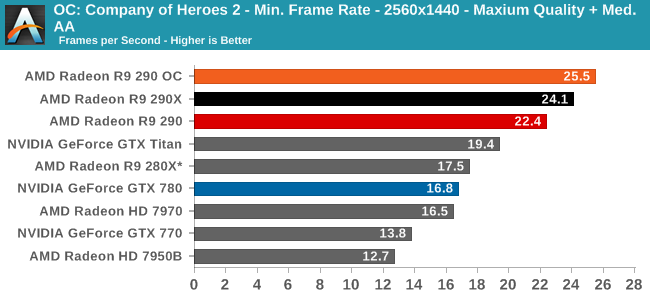
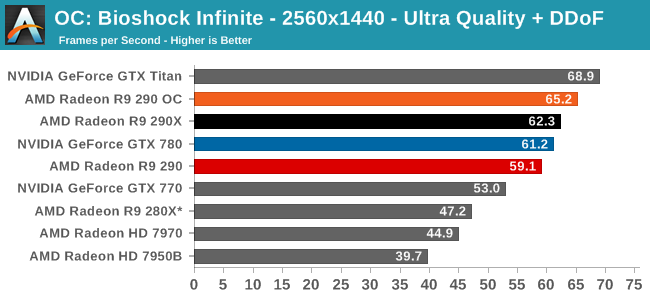
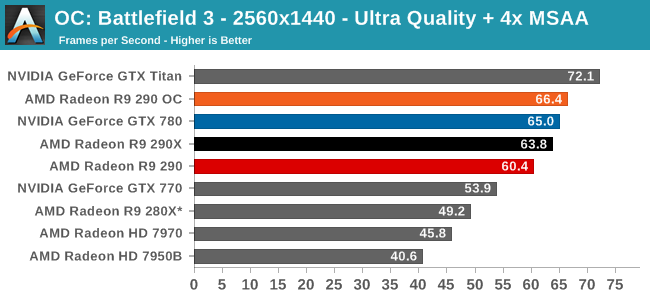
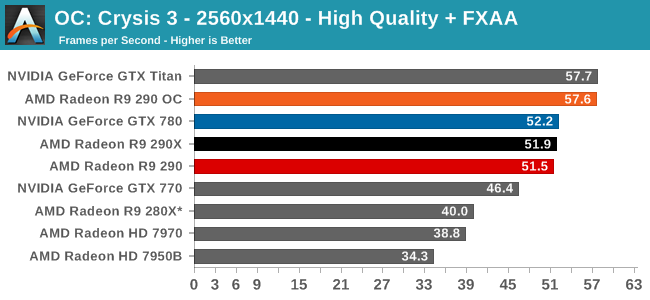
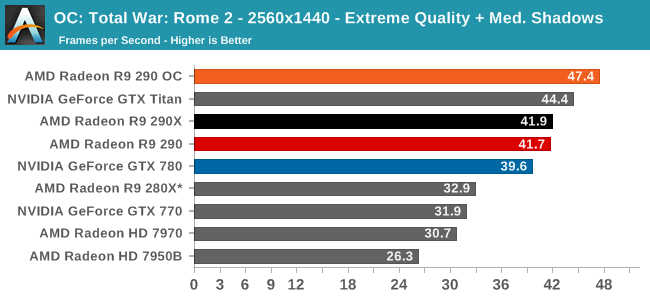
Finally getting to the matter of game performance, we’re seeing consistently strong scaling across every game in our collection. The specific performance increase depends on the game as always, but a 14% core overclock and 12% memory overclock has netted us anywhere between 9% in Metro up to the full 14% in Total War: Rome II. At this performance level the 290 OC exceeds the performance of any other single-GPU card at stock, and comes very close to delivering 60fps in every action game in our benchmark suite.










295 Comments
View All Comments
just4U - Wednesday, November 6, 2013 - link
You have to ask yourself is Ryan biased with Nvidia or AMD... or maybe it's simply just his tolerance for noise that is the issue.Anyway.. people buying these cards will have some options. For me the 95C is a no go as is the noise. Something I'd tolerate until a good aftermarket solution could be implemented. AMD and Nvidia (until their titan reference cooler) have always been a little meh.. with reference coolers. We all know this..
My last two cards have been AMD ones and if I was in the market for a card today I'd go straight for the Nvidia 780. Not because of it's speeds, certainly not because of its drivers, and not because I am a fan. I simply like their kickass reference cooler and games bundle.
Im not in the market though lol. Quite happy with my Radeon 7870.. and not looking to upgrade yet.
jbs181818 - Thursday, November 7, 2013 - link
With all that power consumption, what size PSU is required? Assuming 1 GPU and a haswell CPU, 1 SSD.dwade123 - Thursday, November 7, 2013 - link
290x doesn't make sense when the cheaper 290 performs almost identical. And neither can max out Crysis 3. Gamers are better off waiting for real next-gen cards like Maxwell, and with next-gen console ports coming in 2014 suggests it is common sense to do so.polaco - Tuesday, November 12, 2013 - link
"neither can max out Crysis 3" what the hell are you talking about?52 fps at 2560x1440 HQ + FXAA
77 fps at 1920x1080 HQ + FXAA
with that line of thinking then nor 780 or Titan are worthy since fps diff is minimal
"gamers are better off waiting for real next-gen cards like Maxwell"
well, 290 and 290X are AMD true next gen cards, maybe you feel fooled by having bought a 780 for almost 700 bucks and then you feel like Maxwell will relief that pain, or maybe you work for NVidia marketing deparment... for the time NVidia came out with it AMD will be pushing their next gen too, will you recommend waiting then too? so we wait forever then uh?
"and with next-gen console ports coming in 2014 suggests it is common sense to do so"
you mean to wait for NVidia card to run games that will be optimized to AMD hardware that is inside every next gen console?
please go to see a doctor....
TempAccount007 - Saturday, November 9, 2013 - link
Who the hell uses a reference cooler on any AMD card? The only people that buy reference cards are those who are going to water cool them.NA1NSXR - Monday, November 11, 2013 - link
If I was in the market for a card I'd wait until the aftermarket cooler designs come out. Should make the noise and temp situation a little more bearable. Still, the proprietary nVidia value-adds like HBAO+, adative vsync, TXAA, etc. are hard to give up for me. It is a hard call. If the 780 was only $50 more than the 290 I'd take the 780, but since the difference is $100....I don't know. Really tough call.beck2448 - Tuesday, November 12, 2013 - link
Too noisy and hot.devilskreed - Tuesday, November 12, 2013 - link
Hail High AMD..The gamers saviour!!!Hail High AMD..The price/performance king
Hail High AMD..The peoples choice..
Healthy competition from AMD's side,i stopped buying nvidia after 8800GT :p purely due to price/performance benefits that AMD offers..
bloodbones - Thursday, November 14, 2013 - link
The battle between amd ex ati and nvidia has been around since i was 18 years old and i am 30 now. Over the years i have try a huge numbers of video cards from both companies and the only conclusion is that things have always been the same, nothing change over the years: more or less the same performance and:Nvidia = more expensive cards but more quality cards, lower noise levels lower temps
Ati/Amd = cheaper cards with higher noise levels higher temps
Period.
horse07 - Thursday, November 14, 2013 - link
Guys, when will you update the 2013 GPU benchmarks with the recent R7/R9 and 700 series?